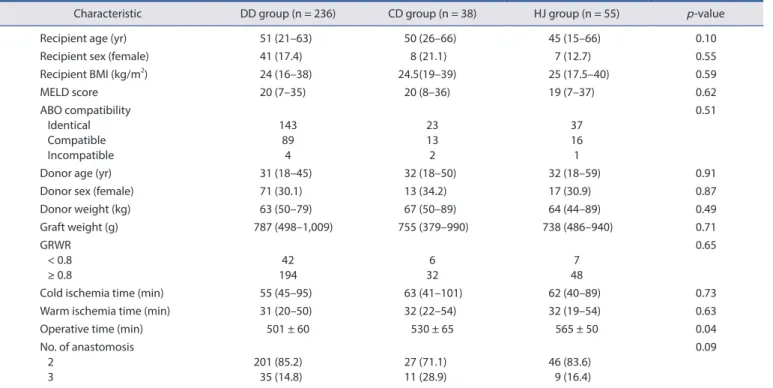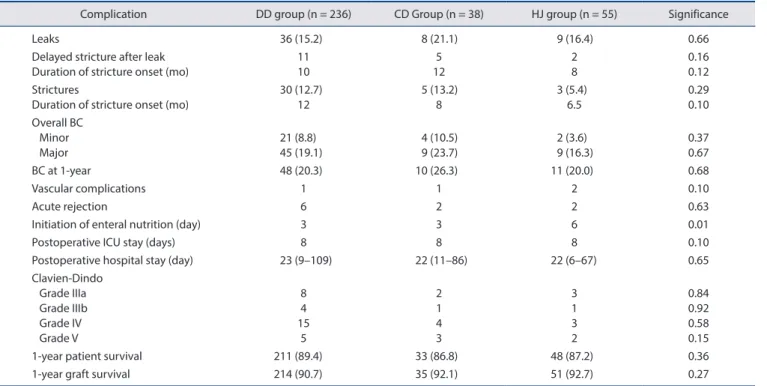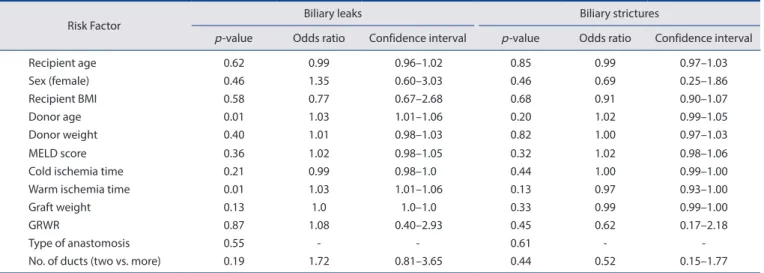Cystic duct anastomosis can be a viable option for biliary reconstruction in case of multiple ducts in
right lobe living-donor liver transplantation
Aarathi Vijayashanker, Bhargava Ram Chikkala, Roshan Ghimire, Ravindra Nidoni, Yuktansh Pandey, Rajesh Dey, Shaleen Agarwal, Subhash Gupta
Centre for Liver and Biliary Sciences, Max Super Speciality Hospital, New Delhi, India
Original Article
Backgrounds/Aims: Multiple ducts in right lobe living-donor liver transplant (LDLT) pose a technical challenge in biliary recon- struction. In the absence of separate recipient hepatic ducts for duct-to-duct anastomoses and certain demerits of hepaticojejunostomy, duct to duct anastomoses with the recipient cystic duct might be a possible solution.
Methods: A total of 329 recipients of LDLT who underwent two or more separate biliary anastomoses at our centre between January 2014 and November 2019 were studied retrospectively. Records of demographic data, donor and graft characteristics, operative details, postoperative biochemical parameters, and biliary complications were analysed.
Results: Of 329 recipients, 236 patients (71.7%) underwent purely duct-to-duct (DD group) anastomoses, 38 patients (11.5%) under- went at least one anastomosis with the cystic duct (CD group), and 55 patients (16.7%) underwent at least one hepaticojejunostomy (HJ group). At one year, biliary complication rates of these three groups were 20.3%, 26.3%, and 20.0%, respectively ( p = 0.68). Postopera- tive intensive care unit and overall hospital stay were similar among the three groups. Grades IIIa, IIIb, IV, and V Clavien-Dindo com- plications were identical. One-year patient survival and graft survival were also similar among the three groups.
Conclusions: Biliary outcomes using the cystic duct may have acceptable outcomes. Similar postoperative results as other means of biliary reconstruction could be anticipated with the cystic duct anastomoses in case of multiple ducts in the graft.
Key Words: Bile ducts, extrahepatic; Surgical anastomosis; Living donors; Liver transplantation; Complications
INTRODUCTION
Multiple ducts in right lobe living-donor liver transplant (LDLT) pose a technical challenge in biliary reconstruction.
Although multiple ducts could be obtained by high hilar divi- sion of recipient bile duct, this may not be advisable in many situations. In cases of hepatocellular carcinoma, margins may
be compromised by division close to the porta. The most prox- imal part of bile duct might be ischemic as the vasculature is arising from below upwards. When ducts are close enough on the hilar plate or in a common sheath, a ductoplasty or duct-to- sheath anastomoses using recipient common hepatic duct may be considered for reconstruction. However, when donor ducts are far apart, their anastomoses to right and left bile ducts might not be feasible always. In sick recipients, anastomosis to jejunum may also be fraught with complications such as risk of enteric leak and delay in initiation of enteral nutrition.
It may also be a technical challenge due to thickened bowel from chronic oedema due to portal hypertension or portal vein thrombosis. In addition, anastomosis to proximal bile duct may introduce a “swan neck deformity”, where the anastomosis is fine but the redundancy of the long bile duct creates an an- gulation, serving as a functional obstruction and making en- doscopic retrograde cholangiography (ERC) difficult. In such situations, anastomosis to the cystic duct may be a solution.
Received: February 22, 2021, Revised: May 15, 2021, Accepted: May 17, 2021
Corresponding author: Aarathi Vijayashanker
Centre for Liver and Biliary Sciences, Max Super Speciality Hospital, New Delhi 110017, India
Tel: +91-7087390183, E-mail: aarthi.18@gmail.com ORCID: https://orcid.org/0000-0003-0850-1101
Copyright Ⓒ The Korean Association of Hepato-Biliary-Pancreatic Surgery
This is an Open Access article distributed under the terms of the Creative Commons Attri- bution Non-Commercial License (http://creativecommons.org/licenses/by-nc/4.0) which permits unrestricted non-commercial use, distribution, and reproduction in any medium, provided the original work is properly cited.


